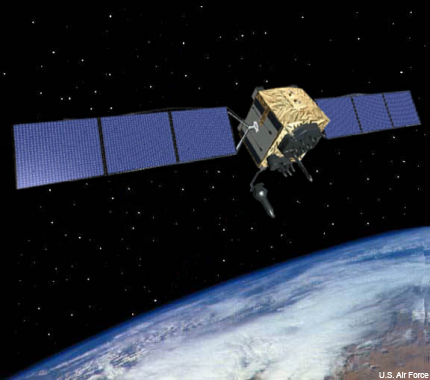Air Force launces ninth GPS IIF satellite as delays continue for GPS III
As funding cuts push back plans for the next generation of satellites, the service says the current constellation can handle the load.

An illustration of a GPS IIF satellite in orbit.
The Air Force today launched the ninth GPS IIF satellite, to upgrade its GPS constellation despite budget-related delays on the planned next generation. The Air Force expects to launch two more GPS IIF space vehicles later this year.
The service says the first eight of 12 total GPS IIF satellites in orbit are meeting mission requirements and the GPS constellation as a whole is “healthy, stable and robust, with 30 operational satellites orbiting the Earth delivering improved and enhanced GPS capabilities to our warfighting forces and the nation,” according to an Air Force release.
Meanwhile, the service is still experiencing setbacks for the GPS III program, which was expected to affordably replace the current GPS satellites. GPS III’s manufacturer, Lockheed Martin (Boeing manufactures GPS IIF) has said GPS III will have a 25 percent longer life capability, three times the accuracy and eight times the effective anti-jamming capabilities.
Cuts in the president’s fiscal 2015 budget reduced the number of GPS III satellites the Air Force was going to purchase, from two satellites per year for the next two years followed by three satellites per year for the successive three years, to one per year for the next two years. Despite plans for GPS III to replace the current GPS infrastructure, the cuts in the 2015 budget forced the military to delay the first GPS III satellite delivery to fall to 2016.
The unexpected longevity of current satellites has reduced the impact of the GPS III delays. The Block IIA satellite generation has lasted longer than previous estimates, with the Block IIF serving in the interim between Blocks IIA and IIIA.
Further compounding woes, a new report from the Government Accountability Office projects further delays for the GPS III. According to reporting by Inside GNSS, the military is redoing its baseline and resetting its estimated schedules and costs associated with the GPS III program.
”Design and technical problems with the mission data unit have been the primary contributors to the 21 month delay in the first satellite's availability for launch,” the GAO report said, adding that the Air Force had underestimated the technical challenges of navigational payloads.
Notwithstanding the shortfalls, the Air Force is updating its satellite constellations. "Significant investments to modernize the GPS constellation are in work, to include higher power from space, military receivers that are more resistant to jamming, new encryption algorithms, key management agility, and innovative software processing to increase resistance to spoofing," Brig. Gen. Bill Cooley, director of Space and Missile Systems Center's Global Positioning Systems Directorate said of the GPS IIF March launch. "We are focused on mission success and stand ready to launch the ninth GPS IIF space vehicle, this will continue modernization of the GPS constellation and maintain the high level of accuracy required by the GPS system.”